A. S. Hinds
Aurelius Stone Hinds was born in Livermore, Androscoggin but was educated in Dixfield, Maine. In 1862, aged 18, he moved to Portland, Maine to work as a clerk for H. H. Hay & Co. and then, after returning home in 1864 for a short time, came back to Portland to work as a drug clerk for Thomas G. Loring in his drug store on the corner of Exchange and Federal Streets.
In 1870, Aurelius went into business for himself after buying a drug store under Preble House on Congress Street, and it was there that he developed the product that would become Hinds’ Honey and Almond Cream.
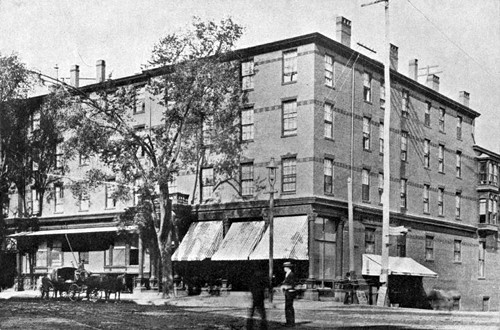
Above: 1892 Preble House.
Hinds’ Honey and Almond Cream
Exactly when the cream was first produced is not clear. There are suggestions that it was made as early as 1873 but it probably did not find a wider market until some 10 years later (‘A preparation of international fame,’ 1903, p. 287).
In the nineteenth century it was common practice for pharmacists to make their own creams for sale using recipes gleaned from pharmacy journals or experimentation. Part of the reason for the local production was the problem of spoilage. The limited shelf-life restricted the sale and distribution of many products. Early cold creams were a good example of this. They did not keep well, particularly in the summer months, and were generally made up as needed. Towards the end of nineteenth century this pattern began to change as new ingredients arrived, distribution networks improved and national advertising became more common. Many proprietary patent medicines and cosmetics began finding markets across the United States and Hinds’ Honey and Almond Cream was one of these.
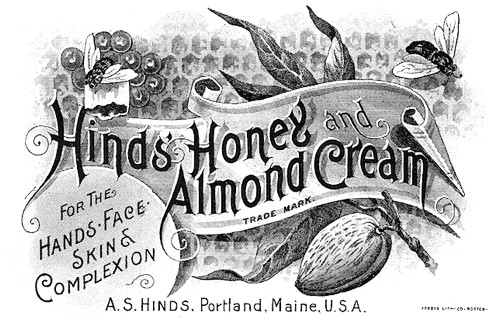
Above: Trade card for Hinds’ Honey and Almond Cream. Honey could not be detected in the formulation and the almond it contained, in the form of oil of bitter almond, was used as a perfume.
See also: Cold Creams
Composition
Hinds’ Honey and Almond Cream was chemically analyzed in 1907 and 1917 and the results compiled by the American Medical Association (AMA) for its members:
Hinds’ Honey and Almond Cream
(A. S. HINDS, PORTLAND, ME.)
Partly saponified beeswax, emulsified and flavored with oil of bitter almond. Alcohol (by volume), 6.4; Solids, 10.97; Borax, glycerin, present; Honey, lanolin, none.—N. H. Bd. of Health San. Bull., 1907, 266.
Essentially an emulsion containing alcohol 7.28 per cent., glycerin 5.79 per cent., partly saponified beeswax 5.98 per cent., crystallized borax 1.49 per cent., perfumed with oil of bitter almond. Alcohol (by volume), 7.28; Solids, 13.26; Ash, 0.86; Ether extract, 5.98; Glycerin, 5.79; Boric acid, 0.97; Sodium, present; Honey, sugar and heavy metals, none.—Conn. Rept., 1914, 300.(Street, 1917, p. 117)
The cream appears to have been a type of beeswax-borax emulsion thinned down so that it could be poured from a bottle. Borax may not have been used in the original formulation and if this was the case then the original product may have shared some similarities with this recipe:
Honey and Almond cream Spermaceti ½ ounce White wax ¼ ounce White Castile soap ¼ ounce Bitter almond, blanched 5 ounces Alcohol 6 ounces Oil bitter almonds 6 drops Oil bergamot 1 drachm Water, distilled 1 pint Rub the almonds with the water, then dissolve the spermaceti by water bath, mix the two, then add alcohol in which the oils have been previously dissolved, alcohol to be added slowly, strain through cheesecloth.
(Fenner, 1898, p. 1638)
Although the product was referred to as a cream it is perhaps better described as a lotion. It was liable to separate on standing and the label included instructions to ‘Shake the bottle before using’.
See also: Hand Balms, Creams & Lotions
Claims
Like other products of the time many of the early advertising claims for Hinds’ Honey and Almond Cream were broad and included medical as well as cosmetic uses, giving the product some similarities with patent medicines.
THE SUPERIORITY OF HINDS’ Honey & Almond Cream consists in its wonderful purifying and healing properties and cleanliness. It is unlike any other preparation for the SKIN AND COMPLEXION in that it contains no Oils, Greasy Substances or Chemicals, neither Starchy or Mucilaginous principles to obstruct the pores of the Skin, is quickly absorbed, leaving no trace of its use, and cannot injure the most delicate of sensitive skin.
It is particularly recommended for rough, hard or irritated skin, chapped hands, face and lips, pimples, scaly eruptions, wrinkles, sunburn, chilblains, burns, scalds, wounds, chafing, ivy poison, stings and bites of insects, inflamed and irritated piles, salt rheum, eczema, and all conditions of the Skin of like character.
Gentlemen after shaving will find it a Superior Lotion for the Face to allay Irritation and prevent soreness.(Hinds trade advertisement, 1893)
See also: Patent Medicines and Cosmetics
Expansion
The success of the product led Aurelius to relocate to a new store on the corner of Pine and Brackett Streets, Portland in 1880. By the early 1880s, Hinds’ Honey and Almond Cream was being sold outside of Portland, and before long the company had agencies in South Africa, South America, Hawaii, Australia and London as well as an additional factory in Montreal, Canada (Gillespie, 1899, p.170). The increased demand resulted in another move to 21 Pine Street, Portland in 1889.
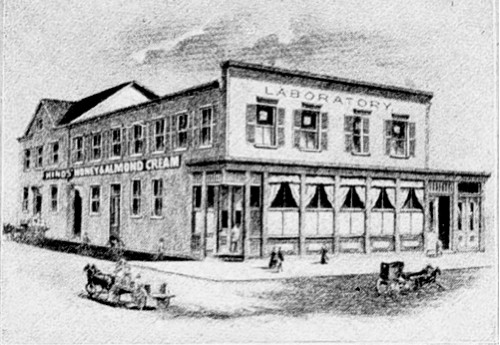
Above: 1889 Hinds manufacturing facilities the corner of Pine and Clark Streets, Portland.
Then, in 1904, the Pine Street site was redeveloped and a new factory built there.
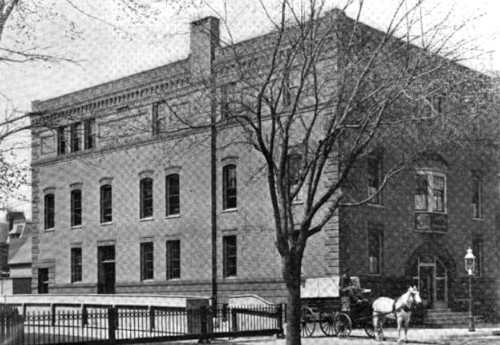
Above: 1905 New facilities on the corner of Pine and Clark Streets, Portland.
By the time the new facilities were completed Hinds’ Honey and Almond Cream was being marketed largely as a cosmetic and most of the patent medicine claims had been dropped. The reason for this change could be a combination of factors: an increasing distrust of patent medicines by consumers; the banning by some reputable magazines like the Ladies Home Journal of advertisements for patent medicines (Peiss, 1998, p. 99); and the passing of the 1906 Food and Drug Act in the United States which put greater restrictions on patent medicines.
Hinds’ Honey and Almond Cream Prevents and Heals Chapped Face Lips and Hands
It quickly softens dry, rough, cracked and bleeding skin; is antiseptic, purifies and cleanses better than soap; promptly heals tender or sore surfaces. If applied before and after exposure, the face will remain in perfect condition during severest weather. Muddy complexions become clear, fresh and attractive with Hinds’ Cream.—Best for Babies’ delicate skin and for men who shave. Guaranteed to contain no grease, bleach or chemicals; will not cause the growth of hair.(Hinds advertisement, 1906)
In 1906, to help promote the product, Hinds also established an advertising department. Then, around 1910, the apostrophe in Hinds’ was dropped and Hinds’ Honey and Almond Cream became Hinds Honey and Almond Cream. Other products were then added to the Hinds brand, starting with Hinds Honey and Almond Cold Cream (1911) and ending with Hinds Disappearing Cream (1919), by which time there were six items in the Hinds’ range:
Hinds Honey and Almond Cream: “not only improves the complexion but keeps the arms and hands attractive. It softens the cuticle in manicuring and relieves tenderness. Men use it after shaving for skin-comfort, to soften and heal.”
Hinds Cold Cream: “contains the same essentials as the liquid cream and is valuable for its cleansing, healing qualities. Good for baby’s skin troubles. A perfect massage cream, semi-greaseless; improves the complexion.”
Hinds Disappearing Cream: “is greaseless, rarely delicate, softening, refining—protects the complexion and adds charm. A perfect base for face powder.”
Hinds Cre-Mis Face Powder: “is impalpably fine and soft, adhering with gratifying smoothness. Its distinctive fragrance enhances the charm of every woman who uses it. Adds a touch of refinement.” Shades: White, Pink, Flesh, Brunette.
Hinds Cre-Mis Talcum Powder: “exquisitely flower-scented, velvety fine, cooling, soothing, comforting to delicate, irritated skin, imparting an exquisite touch of smooth softness.”
Hinds Cre-Mis Soap: “is pure, bland, daintily fragrant and as highly refined as expensive French soaps. Yields abundant lather in either soft or hard (alkaline) water; refreshing, softening to the skin—ideal for the complexion.”
In 1920, new manufacturing facilities were built at 331-337 Forest Avenue, Portland to cope with the increased level of production.
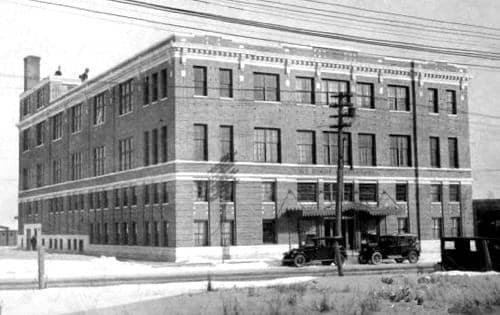
Above: 1924 Manufacturing facilities at Forest Avenue, Portland, designed by the architects John Calvin Stevens [1855-1940] and his son, John Howard Stevens [1879-1958].
The description below outlines the workings of this factory:
The total floor space is 60,181 square feet, as compared with 15,200 square feet in the old laboratory. The construction is of reinforced concrete, partly slab and mushroom type and partly of the ribbed floor construction. The exterior is covered with vitreous cream gray rough textured brick, using the entire run of varying colors from the kiln; the trim is a matt glaze white terra cotta; the roof is practically flat, and so designed that it can be used as the floor of an additional story in the future.
The interior is most interesting; here one finds every modern equipment and the latest devices in plumbing and mechanical contrivances. In the main office, there is a high story with mezzanine floor forming a gallery around the greater part of the room. The entire front, both the first and mezzanine floors, is devoted to the office, while the rear of the first story is used for storage of finished products ready for shipment. Raw materials are received at the rear and carried to the top floor by elevator.
The fourth story covers nearly 3,500 square feet and is so designed as to plan for the future should more room be needed, for it can be carried forward covering the entire building. From this floor materials are delivered by gravity to the laboratory on the third floor where the kettles for cooking and mixing ingredients are located. Dropping from this point are large glass lined containers or tanks, located over the filling machines on the second floor. A special conveyor, or elevator, on the endless chain principle carries empty bottles from the basement story where they are rolled to these filling machines by conveyors, going through cappying [sic.] machines, labeling machines and other assembling units until they emerge by way of a chute completely boxed and ready for shipment in the first story.
A part of the third story, on which is the large dining room, recreation room and kitchen is used for storage and the rear part is given up to the manufacture of other toilet articles by the hinds Company. Another interesting feature is the small hospital room for emergency service.
The building is equipped with a Grimmel sprinkler system and the plumbing is complete and up-to-date, while the steam heat is furnished by two smokeless boilers.(Trade Notes, 1921, p. 259)
One of Aurelius’ sons, Charles Benjamin Hinds [1881-1958], made a film of this factory in operation.
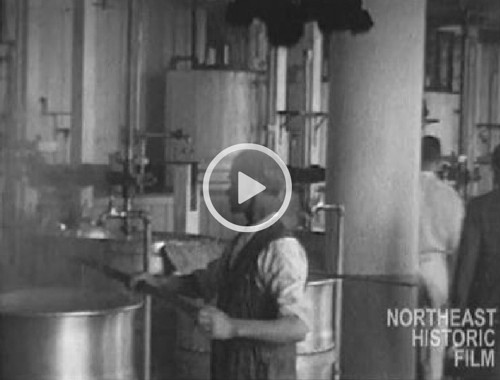
Above: The above link is to a page where you can view a 1925 film about the making of Hinds Honey and Almond Hand Cream along with office scenes at the Portland site (Charles B. Hinds Collection, Northeast Historic Film).
Lehn & Fink
In 1922, A. S. Hinds was incorporated as a Delaware company and, in 1925, was acquired by Lehn & Fink, Inc., a wholesale drug firm based in New York. Founded in 1874, the company was known mainly for Lysol disinfectant and Pebeco tooth pastes and powders.
See also: Lehn & Fink
Lehn & Fink Products was created to acquire the assets of Lehn & Fink, Inc. and the A. S. Hinds Co. and Hinds’ manufacturing was moved to the Lehn & Fink’s factory in Bloomfield, New Jersey.
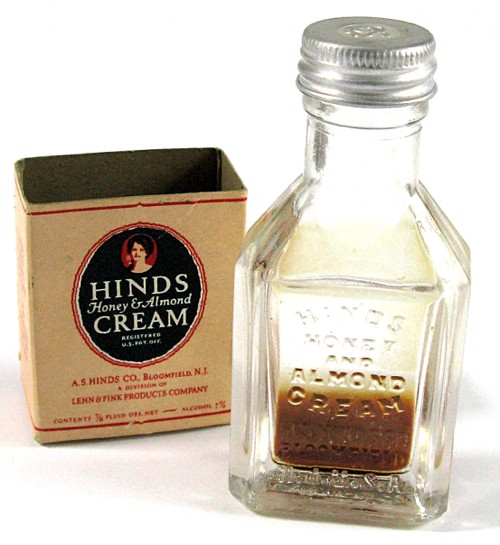
Above: Hinds sample bottle. The label lists the company at Bloomfield, New Jersey so this must have been made after 1925 – probably in the 1930s. The cardboard packaging fits neatly over the bottle. The image of the woman on the front was trademarked.
Local manufacturing was also established in a number of foreign countries including: England, Canada and Germany (1926), Chile, Argentina and Uruguay (1927), Cuba (1928), Brazil (1929), and Australia and Spain (1931). The machinery used was shipped from the United States and manufacturing was done under the supervision of a Lehn & Fink employee to preserve the secrecy of the formulas and processes.
Decline
In 1929, net sales of Hinds Honey & Almond Cream reached their highest point. Sales and profits declined steadily after this due to competition from hand lotions such as Jergen’s Lotion, Campana’s Italian Balm, and Frostilla which were backed by expensive advertising campaigns. Lehn & Fink responded to the decline in sales by increasing the Hinds’ advertising budget and by changing its advertising agency in 1931 and again in 1932. In response to consumer complaints it also altered the formula of Hinds Honey & Almond Cream in 1933, 1934 and 1935, redesigned its packaging and added a new dispenser in 1935.
In 1931, Lehn & Fink introduced three new products into the Hinds range: a liquefying cleanser, a toner and a vanishing cream. None of these new products was successful and they were discontinued early in 1936.
Hinds Cleansing Cream: “The moment you apply, it melts, gently penetrates pores, floats out all dirt and dust. Your skin feels clean and soothed. Its delicate texture is protected.”
Hinds Toning Cleanser: “Go over skin firmly with this cool, green liquid. All dirt and grease disappear. Pore residue goes. Thus pores shrink back to normal size.”
Hinds Texture Cream: “Absorbed rapidly by the skin, this new cream counteracts dryness, tight, drawn feeling, scaliness, tired look.”
During the 1930s, Hinds Honey and Almond Cream was generally promoted as a hand lotion, although its many uses were still mentioned. Advertising suggested it could be used to produce ‘Hostess Hands’, ‘Softened Chapped Hands’ or ‘Smooth Honeymoon Hands’.
In 1936, changes to the tax laws in the United States resulted in Lehn & Fink liquidating the A. S. Hinds Company. Stock which had cost Lehn & Fink over US$5,380,000 was surrendered in exchange for the assets of Hinds, which had a book value of less than US$150,000, a decrease that was indicative of the decline in the brand. However, Lehn & Fink continued with their endeavours to revive the line. In 1937, they introduced vitamin D into the formulation, followed by vitamin A in 1938. Then, in 1940, they introduced two new products into the range, Hinds Hand Cream and Hinds Deodorant Cream.
In 1941, Hinds Honey and Almond Cream was renamed as Hinds Honey and Almond Fragrance Cream to avoid misbranding notices from American Food and Drug Administration (FDA) after the passing of the Food Drug and Cosmetic Act (FD&CA) in 1938.
War
The outbreak of the Second World War triggered a greater interest in hand creams as women looked to protect their hands from roughness or the more serious industrial dermatitis bought about by factory work, e.g., manufacturing munitions.
See also: Barrier Creams & Lotions
Many companies advertised hand creams during the war, including Lehn & Fink. Some changes were also made to the Hinds range during this period. In 1943, Lehn & Fink added a new product, Hinds Complete Facial, an all-in-one face cream-cleanser, softener and powder base and, in 1944, lanolin was added as a softening agent to Hinds Honey and Almond Fragrance Cream.
Post-war
By 1949, Hinds Honey and Almond Fragrance Cream was grouped with other Lehn & Fink Drug Products including Pebeco and Peb-ammo toothpastes, Lysol disinfectants and Etiquet deodorants.
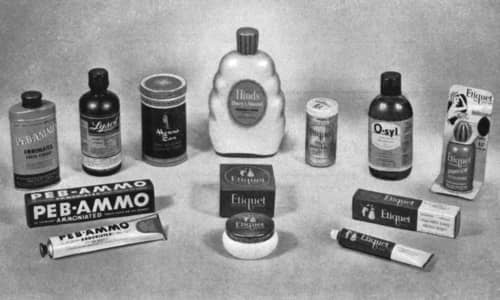
Above: 1952 Products grouped into Lehn & Fink Drug Products aimed at the mass market.
Sales of all products within the group stagnated during the 1950s. Some, like Etiquet deodorants and Henna San hair-rinses, were sold off by Lehn & Fink in 1964 but Hinds Honey and Almond Fragrance Cream was still in production in 1966 when Lehn & Fink was bought by Sterling Drug, Inc.
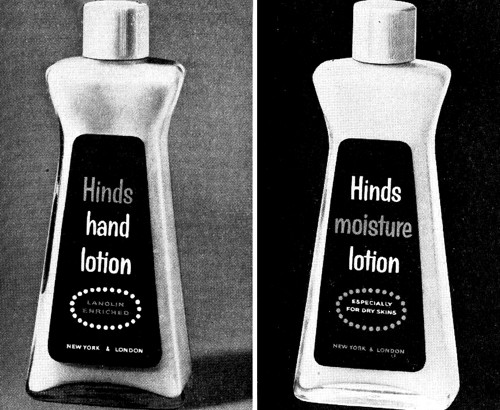
Above: 1959 Hinds Hand Lotion and Hinds Moisture Lotion. The moisturiser was designed for dry skins and contained lanolin, vitamins and sorbitol. Both products were competing largely on price.
Although Hinds Honey and Almond Fragrance Cream is no longer in production, other cosmetics badged under the Hinds brand are still being made. They underwent a resurgence this century after SmithKline Beecham, now GlaxoSmithKline, acquired the brand. The current products which include infant skin-care and general body lotions are produced primarily for the Mexican and South American markets.
Timeline
| 1870 | Aurelius Stone Hinds purchases a drug store in downtown Portland. |
| 1873 | New Products: Hinds’ Honey and Almond Cream. |
| 1875 | A. S. Hinds Company founded by Aurelius Stone Hinds in Portland, Maine. |
| 1880 | A. S. Hinds moves to new store on the corner of Pine and Brackett Streets, Portland. |
| 1889 | A. S. Hinds relocates to new store on the corner of Pine and Clark Streets, Portland. |
| 1904 | New laboratory built on the corner of Pine and Clark Streets, Portland. |
| 1906 | Advertising department established and sales policy adopted. |
| 1911 | New Products: Hinds’ Honey and Almond Cold Cream. |
| 1919 | New Products: Hinds’ Disappearing Cream. |
| 1920 | New manufacturing facilities built in Forest Avenue, Portland. |
| 1922 | A. S. Hinds Company becomes a Delaware corporation. |
| 1924 | Manufacturing begins in Mexico City, Mexico. |
| 1925 | A. S. Hinds bought by Lehn & Fink Products. Manufacturing moved to Bloomfield, New Jersey. |
| 1926 | Hinds introduced into England, Canada and Germany; A.S. Hinds Ltd. (London), A. S. Hinds (Canada) Ltd., and A. S. Hinds, A.G (Germany) established. |
| 1927 | Manufacturing begins in Santiago, Chile, Buenos Aires, Argentina and Montevideo, Uruguay. |
| 1928 | Manufacturing begins in Havana, Cuba. |
| 1929 | Manufacturing begins in Rio de Janeiro, Brazil. |
| 1931 | Manufacturing begins in Sydney, Australia and Madrid, Spain. New Products: Hinds Texture Cream; Hinds Cleansing Cream (a liquefying cleanser); and Hinds Toning Lotion. |
| 1933 | Hinds Honey & Almond Cream formula changed. Formula altered again in 1934 and 1935. |
| 1936 | A. S. Hinds Company dissolved. |
| 1937 | Vitamin D added to Hinds Honey and Almond Cream. Vitamin A added in 1938. |
| 1940 | New Products: Hinds Deodorant Cream; and Hinds Hand Cream. |
| 1941 | Hinds Honey and Almond Cream renamed Hinds Honey and Almond Fragrance Cream. |
| 1943 | New Products: Hinds Complete Facial. |
| 1945 | Lanolin added to Hinds Honey and Almond Fragrance Cream. |
| 1954 | ‘Floratex’, a special protective ingredient, added. |
| 1966 | Lehn & Fink Products Corporation acquired by Sterling Drug, Inc. |
Updated: 28th November 2018
Sources
A preparation of international fame. (1903). Board of Trade Journal, 16, 287. Portland, Me: Portland Board of Trade.
Fenner, B. (1898) Supplement to Fenner’s complete formulary. Westfield, NY: Author.
Gillespie, C. B. (Ed.). (1899). Portland past and present. Portland: Evening Express Publishing Company.
Peiss, K. (1998). Hope in a jar: The making of America’s beauty culture. New York: Henry Holt and Company.
Street, J. P. (1917). The composition of certain patent and proprietary medicines. Chicago: American Medical Association.
Strianse, S. J. (1957). Hand creams and lotions. In E. Sagarin (Ed.), Cosmetics: Science and technology (pp. 147-181). New York: Interscience Publishers Inc.
Trade Notes. (1921). The American Perfumer and Essential Oil Review, XVI(6), 255-260.
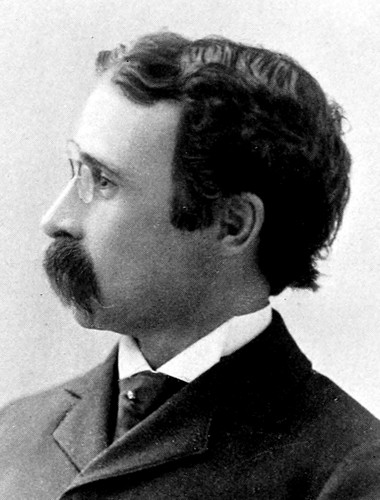
Aurelius Stone Hinds [1884-1929]. He married Ellen Elizabeth Noyes in 1872 in Portland, Maine and they had four children. He died at sea on a Mediterranean cruise.
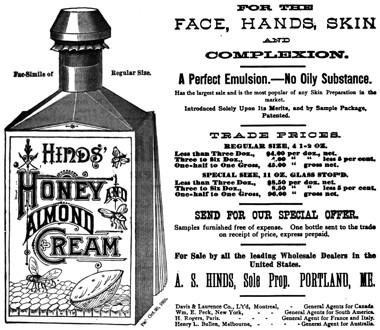
1892 Hinds’ Honey and Almond Cream.

1895 Hinds’ Honey and Almond Cream.
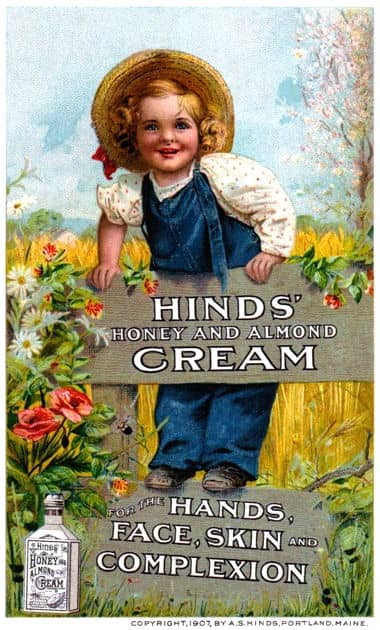
1907 Hinds’ Honey and Almond Cream.
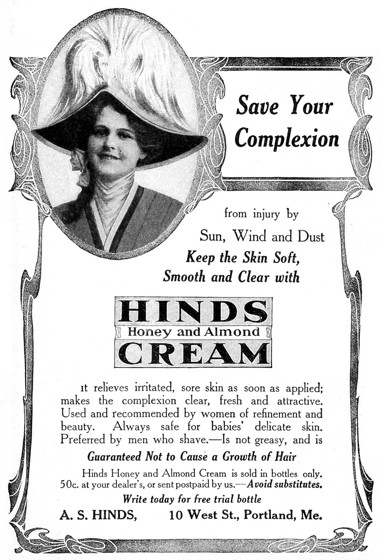
1910 Save Your Complexion with Hinds Honey and Almond Cream.
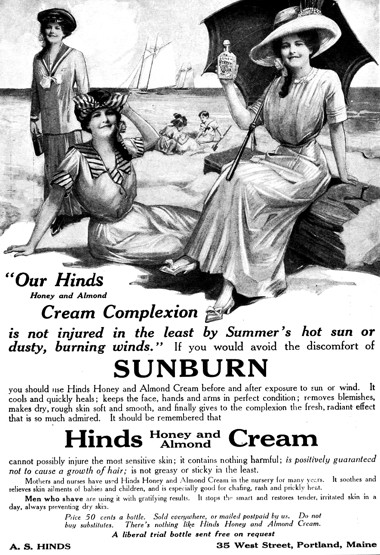
1911 Hinds Honey and Almond Cream for sunburn.
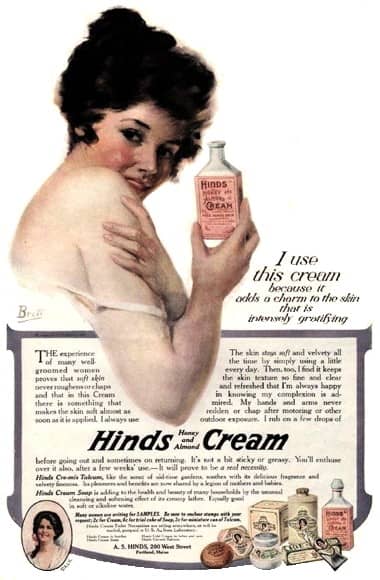
1918 Hinds Honey and Almond Cream and other toiletries.

1920 Hinds Toiletries.

1922 Hinds Honey and Almond Cream, Cold Cream, Disappearing Cream and Cre-mis Face Powder.
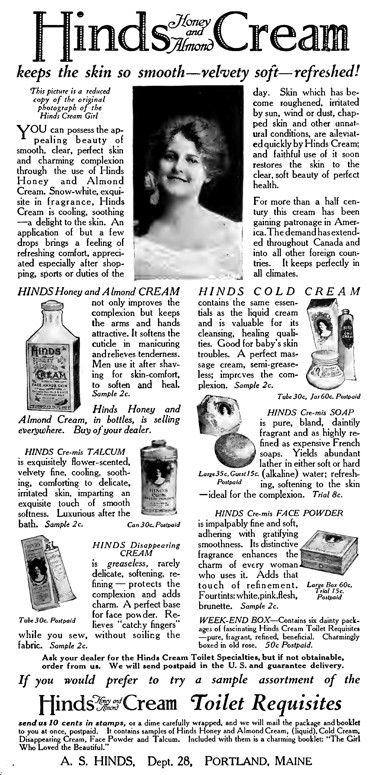
1923 Hinds Toiletries.
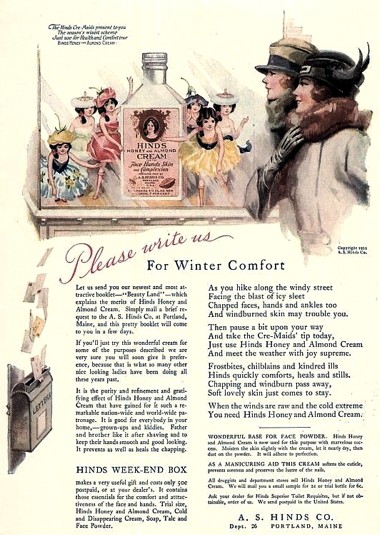
1923 Hinds Honey and Almond Liquid Cream for ‘Winter Comfort’.

1928 Hinds Honey and Almond Liquid Cream skin protectant.

1931 Hinds Cleansing Cream, Toning Cleanser and Texture Cream.
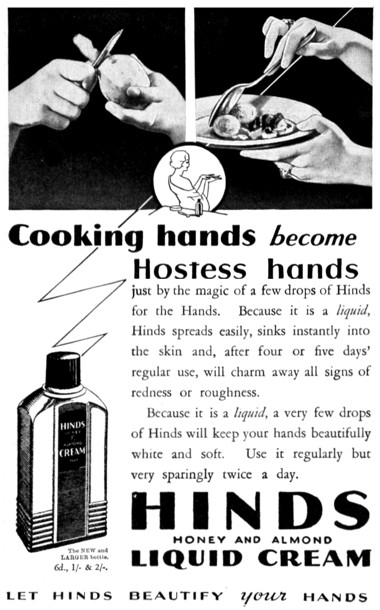
1934 Hinds Honey and Almond Liquid Cream.
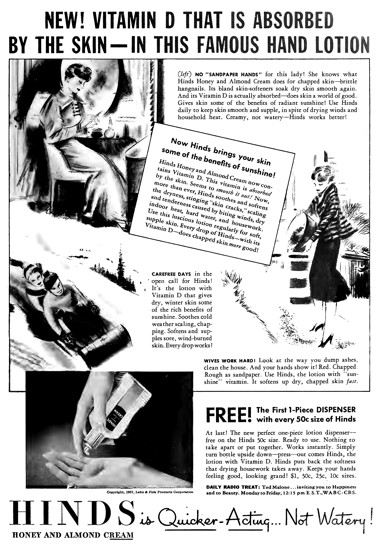
1937 Hinds Honey and Almond Cream with vitamin D in the new dispenser introduced in 1935. Vitamin A was added in 1938.
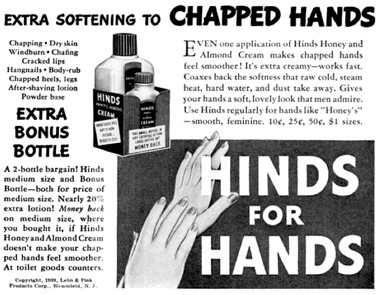
1939 Hinds for Hands.

1944 Hinds for Hands. Hinds Honey and Almond Fragrance Cream and Hinds Complete Facial.
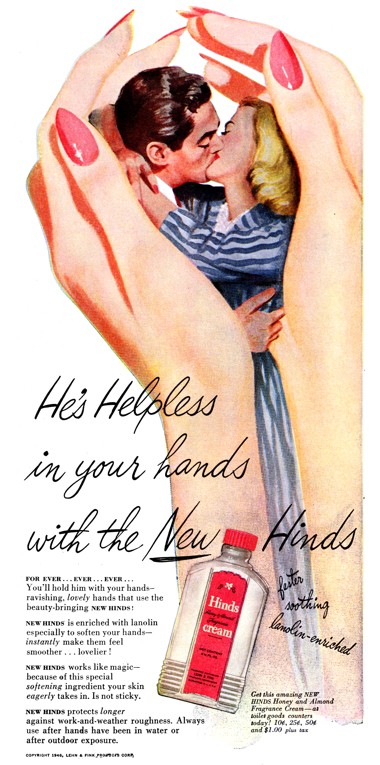
1946 Hinds “He’s Helpless in your Hands” campaign. The cream now contains lanolin. Romance leading to marriage was used a lot in advertising in the years after the Second World War.
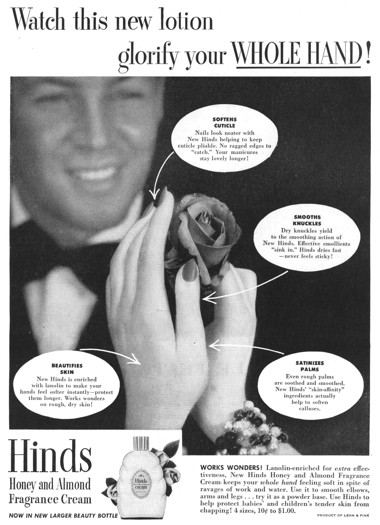
1949 Hinds Honey and Almond Fragrance Cream in a new ‘beauty bottle’.
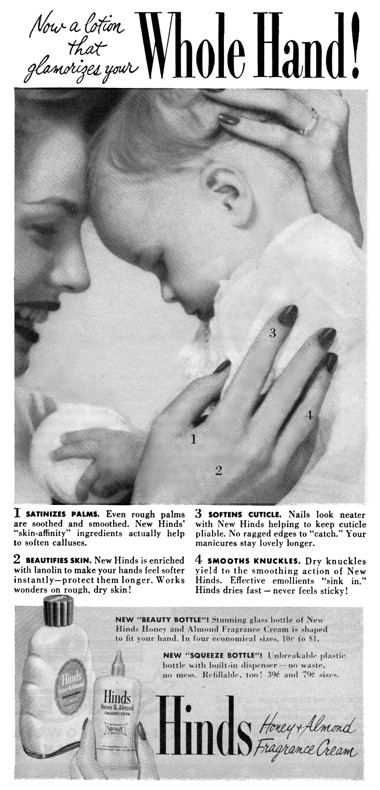
1950 Hinds Honey and Almond Fragrance Cream. Pictures of women holding babies or small children were common in the baby boom of the 1950s.
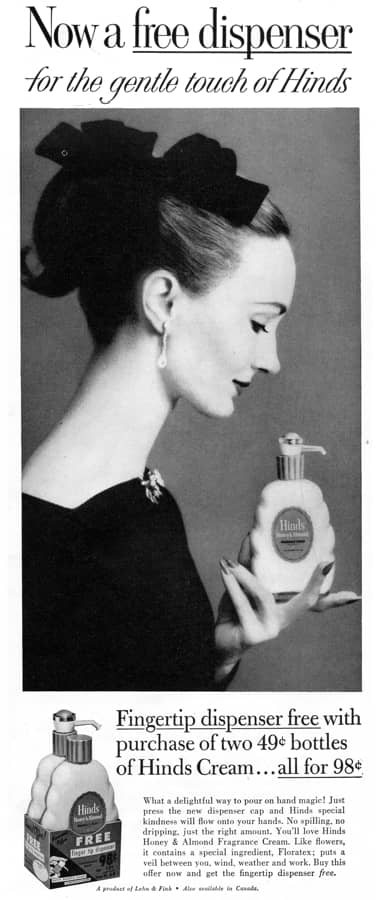
1956 Hinds Honey and Almond Fragrance Cream with dispenser.
